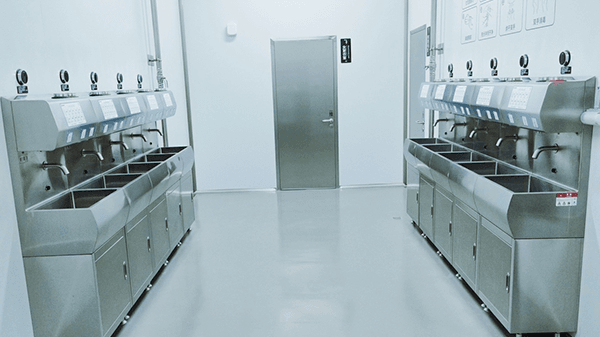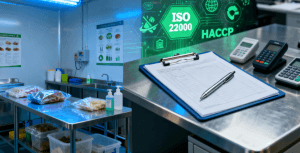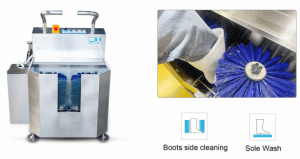The BRCGS Food Safety Standard is explicit about the requirements for handwashing facilities. Their placement is critical to preventing cross-contamination.
Here is where hand wash basin must be applied in a food factory according to BRC:
1. Entrances to Production and Processing Areas:
Location: At the entry point to any food handling or open product zone, after changing into protective clothing.
BRC Rationale: To ensure every employee’s hands are clean before they have any contact with the production environment. This is the primary barrier against external contamination.
2. Entrances to High-Risk/High-Care Areas:
Location: Immediately inside the doors of areas designated for handling ready-to-eat (RTE) products, exposed products, or cooked products.
BRC Rationale: This acts as a final, critical control point to prevent pathogens (e.g., Listeria, Salmonella) from entering the most sensitive areas. BRC emphasizes strict segregation, and handwashing is a key part of this protocol.
3. Adjacent to Toilet Facilities:
Location: Inside all toilet facilities and ideally also at the exit leading back to production areas.
BRC Rationale: Mandatory for basic hygiene after using the toilet. BRC requires clear signage instructing employees to wash their hands.
4. Within the Production Area:
Location: Strategically placed throughout the production floor so they are easily and quickly accessible to all personnel (operators, quality staff, maintenance).
BRC Rationale: To encourage frequent hand hygiene after tasks that could contaminate hands (e.g., handling waste, touching face, picking up an item from the floor).
5. At Transition Points Between Raw and Ready-to-Eat Zones:
Location: At the physical barrier (e.g., a doorway) separating areas handling raw materials from areas handling cooked or RTE products.
BRC Rationale: This is a mandatory requirement to prevent cross-contamination. Moving from a raw side to a high-care side always requires a full hand wash.
BRC Requirements for the Stations Themselves:
Hands-Free Operation: Taps must be knee-, foot-, or sensor-operated to prevent re-contamination of clean hands.
Supplies: Must be equipped with:
Potable water at a suitable temperature.
Liquid soap.
A hygienic hand-drying method (e.g., single-use paper towels or hot air dryers).
A designated hand sanitizer dispenser (often alcohol-based) for use after washing and drying on visibly clean hands.
Design: Must be made of materials that are easy to clean and maintain, with drainage directly to a waste pipe.
When it comes to food safety, few things are as fundamental—or as critical—as proper hand hygiene. For sites certified to the BRCGS Food Safety Standard, the placement of handwash stations is not a suggestion; it’s a strict requirement detailed in the protocol.
Getting this right protects your consumers, your product, and your brand. Misplacing a station can create a point of cross-contamination, leading to a non-conformance in your next audit or, worse, a product recall.
This guide breaks down the essential locations for handwash stations in your facility, directly aligned with BRCGS requirements.
Why Handwash Station Placement is a BRC Priority
BRCGS views handwash stations as a primary defensive barrier against contamination. Their standard emphasizes a “right first time” approach to facility layout (Clause 4.4) to control hazards. Properly located stations are a core part of your prerequisite programs (PRPs) and are essential for demonstrating a commitment to product safety.
A station isn’t just a sink. According to BRC, it must be equipped for a full process: Wash, Dry, and Sanitize.
The 5 Critical Locations for BRC Handwash Stations
1. Main Entrances to Production Areas
This is your first line of defense. Stations must be located at the point where employees transition from changing rooms (low-risk) into the production or packaging areas (high-risk). Every single person entering the floor must wash, dry, and sanitize their hands here before touching any equipment or product.
2. Entrances to High-Risk & High-Care Zones
If you handle ready-to-eat (RTE) products, this is non-negotiable. A dedicated handwash station must be installed immediately inside the entrance to any high-risk or high-care area. This serves as a final hygiene gate to prevent pathogens like Listeria from entering this ultra-sensitive environment. Even if an employee washed their hands at the main entrance, they must repeat the process here.
3. Directly Adjacent to Toilet Facilities
BRC mandates handwash stations inside all toilet facilities. Furthermore, it’s a best practice to have an additional station just outside the toilet exit as a reminder before an employee re-entents the production flow. Clear signage—”All personnel must wash their hands before returning to work”—is required.
4. At Raw-to-RTE Transition Points
This is one of the most crucial control points in any food factory. A physical barrier and a dedicated handwash station must separate areas processing raw materials from those handling cooked or RTE products. No one should be able to move from the raw side to the clean side without performing a full hand hygiene procedure. BRC auditors will specifically check this.
5. Throughout the Production Floor
Convenience drives compliance. Stations must be strategically placed within the production area itself so that employees can easily access them after:
Handling waste
Touching their face or hair
Picking up an item from the floor
Taking a break
Performing maintenance tasks
Easy access encourages frequent use, making your entire operation safer.
What Makes a BRC-Compliant Handwash Station?
It’s not just about location; the station itself must meet strict criteria:
Hands-Free Taps: Knee, foot, or sensor-operated to prevent re-contamination.
Hygienic Drying: Single-use paper towels or certified hot air dryers.
Designated Sanitizer: An alcohol-based sanitizer dispenser for use after washing and drying.
Easy-to-Clean Surfaces: Constructed from stainless steel or other smooth, non-absorbent materials.
Well-Maintained: Always stocked with soap, towels, and sanitizer.
Conclusion: Hygiene by Design
Placing handwash stations isn’t about checking an audit box. It’s about thoughtfully designing your facility’s flow to embed hygiene into every process. By installing fully equipped stations at these five critical locations, you build a robust defense against contamination, ensure BRCGS compliance, and most importantly, uphold your duty to produce safe food.




